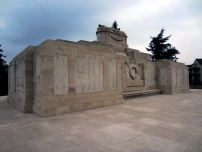| First Name: | Edward Thomas | Last Name: | PINDER | |
|---|---|---|---|---|
| Date of Death: | 15/09/1914 | Lived/Born In: | Norwood | |
| Rank: | Private | Unit: | Liverpool (Kings)1 | |
| Memorial Site: | La Ferte-sous-Jouarre Memorial, France | |||
Current Information:Age-21 22, Rothschild Street, West Norwood
The Battle of the Aisne 13th September -28 September, 1914 After the Germans were defeated on the Marne they fell back to the River Aisne, closely pursued by both the British and the French. The new German line was a very formidable defensive position. To attack it meant having to cross the Aisne and then climb up a 500 foot high ridge on top of which was the Chemin des Dames, a road that gave the Germans an easy way to move troops along the top of the hills. On 13th September the Aisne was crossed by both British and French troops but after that progress became slower, until there was no progress at all. Both sides dug in and the fighting settled down into trench warfare. The fighting on the Aisne continued for two weeks at the end of which both sides realised that frontal attacks on entrenched positions were both costly and non-productive, not that this deterred them from continuing with this tactic throughout the war. At 5am on 14th September, 1914, 6 Brigade of 2nd Division began crossing the pontoon bridge over the River Aisne at Pont Arcy. In front, 1st Berkshire with two troops of 15th Hussars pushed on towards Braye up the long valley between the Oise and Aisne canal but at 9am were checked by heavy shell and rifle fire when they reached a point half way between Moussy and Braye. The 1st Liverpool (Kings) battalion were brought up on their right and at 10.30am, 6 Brigade attacked . On the right two companies of 1st King’s Royal Rifle Corps moved along the summit of the Moussy spur and to their left, 1st Liverpool moved through the woods on the western slope of this spur. They advanced under heavy howitzer fire to the foot of the main ridge of the Chemin des Dames and there they were checked. A later German counter attack pushed 1st Berkshire and 1st Liverpool back to a position abreast of Beaulne where they dug in along a line running from the Beaulne Spur to the canal and where they remained for the next week. It was seven days of very wet weather, constant shelling, patrolling and having to fight off counter-attacks. The casualty list steadily rose and included Edward Pinder who was killed on 15th September. |
||||
| « Back to Search Results | ||||
| If you think any of the information shown here is incorrect, Click Here to submit your amends and comments | ||||




